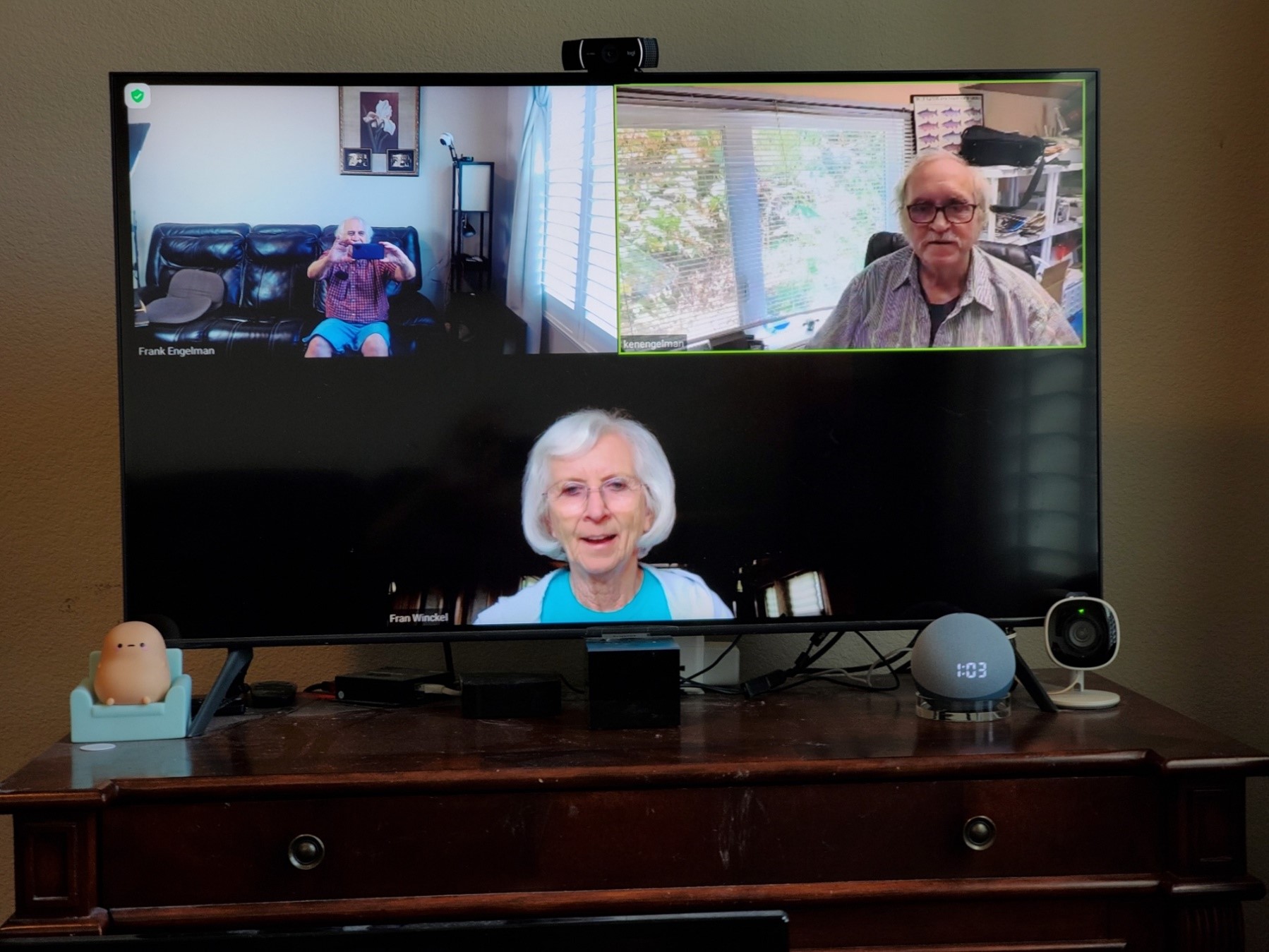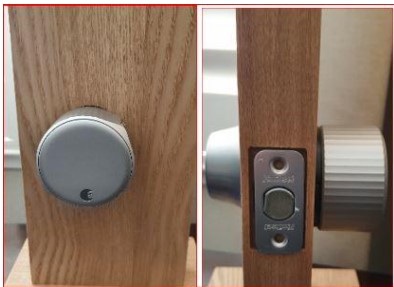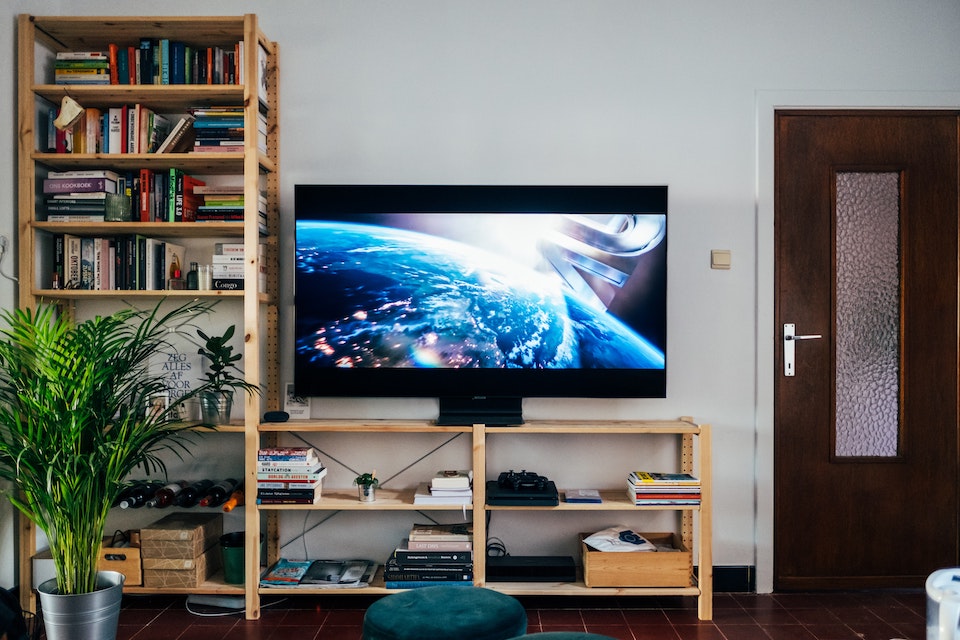By: Frank Engelman | Posted: October 14, 2021 | Updated: March 22, 2023
Photo by Jonas Leupe on Unsplash
As part of our “Smart Home Features for Older Adults” series, we are sharing some specific recipes and “kit lists” for individual smart home features — organized on a “room by room” basis. This is about the smart living room.
Overview
This article covers several smart living room features that author Frank Engelman has found useful for family members or friends — and that focus on “challenges” of particular relevance to people as they age.
Here are the key smart living room features Frank has implemented (detailed recipes and “kit lists” included below):
- Entertainment: Better TV, Consolidated remote Controls; Automatic Music, Video, Photos;
- Socialization: Zoom, Alexa Calling, and Photo Sharing — all on the big screen TV;
- Safety: See who is at the door; smart door locks;
- Automating Lighting, Shades, Fans; and Fireplaces;
- Daily Activities: Reminders for various things.
Table of Contents
- Overview (this section)
- The Challenges and Opportunities
- Recipes & Kit Lists
- DIY Tips & Implementation Suggestions
Who Should Read This and Why?
The Smart Home Features for Older Adults series is for anyone who is an older adult, or cares for an older adult, and who likes the idea that some “intelligent home features” might improve quality of life in various ways, and help minimize some of the challenges that come with growing older.
This particular article focuses on the bedroom. For background and the bigger picture, see Smart Home for Seniors: What and Why?.
- To understand some of the “challenges” smart living room features can address, read the section on “The Challenges and Opportunities“.
- To see specific detailed recipes (and “kit lists”) for DIY implementations, see “The Recipes & Kit Lists” section.
Things to Note
- Frank likes Alexa (a voice enabled artificial intelligence (AI) made by Amazon), and most of these recipes rely on Alexa as the “brain” that enables the smart solutions to work, and makes a simple voice interface possible.
- Frank’s “recipes” assume a certain amount of DIY capability and tech-savvy-ness on the part of whoever installs these smart living room features. However, the recipes assume that the older adult need have no technical capabilities at all.
Disclaimer: This work was not sponsored by Amazon or any other vendor. If you use the outgoing links to vendors in our “kits” and recipes, we may in some cases earn a small commission.
The Challenges and Opportunities
In the living room, the smart home features we are gravitating toward are more about “enhancing life” than “overcoming challenges”.
Entertainment
For most of us, the living room is the entertainment hub and the center of that is the TV.
Let’s explore some ways to make it easier to use for you or a remote loved one, as well as different content that it can provide using the Amazon Fire TV Cube. The Amazon Echo Show also makes a great couch-side device offering music and family photo slide shows.
- See the “Recipes and Kit Lists” section below for specific examples.
Socialization
If you find that you aren’t going out as often as you used to, there still are great ways to keep in contact with friends and family.

Caption: Family Zoom on TV
The popularity of Zoom has provided many hours of enjoyment with my remote family members.
I meet with my brother and sister every week at a fixed time and it feels like we are actually visiting each other.
The online sharing of photos and YouTube videos where we jointly comment on them and can see each other’s expressions is great.
- See the “Recipes and Kit Lists” section below for specific examples.
Safety
Smart locks and Video doorbells can be both labor saving devices and enhance safety.

Caption: Smart Door Lock
One of the problems I have seen with friends and family is that they feel like they must jump up and answer any doorbell ring.
I personally like to check the camera and see if it’s worth getting up.
- See the “Recipes and Kit Lists” section below for specific examples.
Automation
As in all rooms, the most important thing to automate is lighting. But since we spend most of our waking hours in the living room, there are other devices worthy of automation as well.
Let’s automate those floor and ceiling fans, fireplaces, and shades.
- See the “Recipes and Kit Lists” section below for specific examples.
Cognition Issues and Forgetfulness
We think “smart” features can be especially appropriate in situations where an older adult starts to become forgetful, or enters the early stages of cognitive impairment.
The idea that a smart home can help in cases of memory impairment or dementia is not a new one. However recent advances make it much more realistic to incorporate such ideas into an individual’s home.
The key building blocks are:
- the general availability of voice assistants such as Alexa and retrofit devices for switches, lights, and door locks; and
- the ability of Alexa to serve as a proactive controller and friendly reminder of daily activities.
This will be a recurring theme as we move from room to room in this Smart Home Features for Older Adults series. Below are some specific challenges that have the living room as their location.
In the context of the “Living Room”, below you will find some solutions for reminders and shared calendaring.
Most of us could use some reminders of daily tasks. This is especially important for a loved one with memory loss. We will cover daily scheduled reminders for things such as vitamins, drinking water, exercise, and medical appointments.
- See the “Recipes and Kit Lists” section below for specific examples.
Recipes and Kit Lists
The following Recipes (& Kit Lists) are authored by Frank Engelman.
1: Entertainment
The living room is where most of us have an “entertainment setup” and usually it’s a TV.
The control of that TV can become complicated when we have more than one HDMI source connected to it such as cable/satellite boxes, over-the-air TV, DVD players, and streaming devices such as Roku. Each of these come with their own remote and become overwhelming, especially if you have a couch like me that loves to eat remotes!
Better TV and Remote Controls
I suggest consolidating remotes through an Amazon Fire TV Cube as described in “How to Set Up an Amazon Fire TV Cube” .
The Fire TV Cube offers a lot more than just consolidation of remotes, as it can be voice-controlled and even offers a pleasant change from Daytime TV shows. Here is the article “Making TV Useful For My 94-yr-old Aunt” on the various uses of a Fire TV Cube.
There are even 360-degree videos that you can move around inside with your Fire TV Cube remote.
See YouTube 360-degree VR videos on the Big Screen TV in this video
Automatic Music, Photos, Video
In addition to TV as entertainment, I have found that I really enjoy music being automatically played at specific times in the morning to keep me on schedule. This can be accomplished as described in “Solution: Make Alexa Proactive: Create Routines” .
If you are setting this up for a loved one who would enjoy scheduled family photo slide shows, I suggest looking at this article “Solution: How to Share Photos on Echo Show”
If your loved one is starting to forget family members, you could try “Solution: Daily Family Remembrance Video” .
If you want to implement living room entertainment features:
- see the Smart Living Room Kit List for specific products and Routines to use.
2: Socialization: Zoom, Alexa Calling, Photo Slideshows
Due to restrictions of the Covid-19 lockdown, many of us have learned how to use video calling services with our friends or family.
Zoom is very popular due to being free, being supported on many devices and does not require the creation of an account.
See Zoom on the Big Screen TV in this video
Here are some articles on using Zoom with friends and family
- “Want Joint Activity with Distant Relative?”
- “Making Zoom Even Easier”
- “Solution: Zoom Meetings on Mom’s TV”
Alexa video calling is also very popular due to its ability to be voice-controlled and even offers a drop-in mode where your remote loved one does not need to take any action to answer video call.
See Alexa Calling on the Big Screen TV in this video
Here are some articles on using Alexa Calling with friends and family
Showing a family photo slide show is a great way to feel connected
If you want to implement living room entertainment features:
- see the Smart Living Room Kit List for specific products and Routines to use.
3: Safety
Although it’s great to have a doorbell camera, I have noticed that several of my elderly relatives tend to jump up to answer the door before checking it.
Here is a way to implement a gentle reminder to help ensure that they check the doorbell camera.
Smart door locks are also another great way to add security especially if you add a means to easily check them to see if they are closed.
Here is a smart lock that has a very simple installation process.
If you want to implement living room entertainment features:
- see the Smart Living Room Kit List for specific products and Routines to use.
4: Automation: Lighting, Fans, Shades, Fireplaces
One of the most useful automations for any room is lighting.
We have covered it in detail in “Solution: Simple Smart Home Lights”, but I find that living room lighting is one of the most interesting to implement.
Who still struggles with having to reach up to a floor lamp twist knob while sitting on their easy chair?
The room lighting in a living room may need to change several times a night when switching from reading to watching a TV show. This is all made easier with Alexa voice controls or buttons.
While lighting control is great, what about those floor and ceiling fans that need to be turned on/off, even with great central air conditioning?
Well, there are two basic types of remote fan controls, IR and RF. The floor fans tend to use IR remotes while ceiling fans, fireplaces, shades, and split AC systems use RF.
Although they both can be controlled by Alexa, I use different control systems for each type.
For the IR remotes, I recommend the YoLink IR controller and for RF devices the Bond bridge. Both of these devices come with great setup instructions and require the installation of an Alexa Skill. You can speak the commands through Alexa or create Alexa Routines.
One bonus feature of these controllers versus handheld remotes is that they can be activated by time of day, temperature, or when you are away from home to get the house ready for your arrival.
If you want to implement living room entertainment features:
- see the Smart Living Room Kit List for specific products and Routines to use.
5: Activity and Reminders
Daily reminders are a great way to stay on track and feel connected.
See “Take your Vitamins” Reminders in this video
They could be used for routine things such as remembering to eat or drink enough water or even taking non-prescription medicine as shown in the video above. They can also be used to give a “daily briefing” of what’s on the calendar.
I suggest that in addition to a verbal reminder that, you also provide a visual reminder that requires confirmation. This is helpful if you are out of the area when the reminder is announced, or if you prefer to delay performing the action at that time.
In addition to timed reminders, I suggest using Alexa to proactively inform of calendar events such as appointments coming up shortly.
This can be especially useful if you are managing a remote loved one’s calendar.
If you want to implement living room entertainment features:
- see the Smart Living Room Kit List for specific products and Routines to use.
DIY Tips & Implementation Suggestions
If you aren’t familiar with Alexa Routines, I suggest you review the “Solution: Make Alexa Proactive: Create Routines” and “Solution: Making It Easier to Command Alexa” articles.
- One trick that I use is “copy actions to a new routine” which saves the step of re-writing the same actions for different triggers.
- For Routines that are “event-triggered” such as by motion detectors or contact closures, you can change the “anytime” condition to a specified range of time so that you can either not perform the action or modify it based on time of day. For example, I did not want the “door check” announcements to speak the lock status if I got out of bed at 3 AM
- A relatively new feature that I use in my Routines is the “custom actions” feature. This allows an Alexa Routine to activate the same command that you would normally speak to Alexa. This means I can use a custom action that says “Alexa, lock the Casita door lock” and Alexa will do it silently.
- This is a major improvement in Alexa Routines, but it has a limitation that I needed to overcome. This is that there can be only ONE custom action in a Routine and it must be the LAST action of the Routine. The way I get around this is to have another Alexa Routine triggered by the same event, delayed by a few seconds, that performs the needed second custom action. I use this to provide the required “unlock PIN code” to the door lock.
- This is a major improvement in Alexa Routines, but it has a limitation that I needed to overcome. This is that there can be only ONE custom action in a Routine and it must be the LAST action of the Routine. The way I get around this is to have another Alexa Routine triggered by the same event, delayed by a few seconds, that performs the needed second custom action. I use this to provide the required “unlock PIN code” to the door lock.
- If you are looking for a tutorial on SmartThings Automations or IFTTT applets, I’d suggest that these are best learned by looking at samples.
- The problem with Routines, Automations, and Applets is that they need an “event” to trigger them. I use a virtual switch set by Alexa to cause the Automation to change the state of the virtual switch triggering IFTTT which in turn triggers Alexa to speak. While you could ask Alexa the state of each of these devices, there is no way to ask Alexa for a “summary” of device states.
Learn More
- For the big picture about smart homes and older adults see Smart Home for Seniors: What, Why? and the Topic Hub: Smart Home, Artificial Intelligence, Robots.
- Feel free to add questions or comments below in the comments section.
- Want to join our community and engage more deeply? See below.
*Disclosure: The research and opinions in this article are those of the author, and may or may not reflect the official views of Tech-enhanced Life.
If you use the links on this website when you buy products we write about, we may earn commissions from qualifying purchases as an Amazon Associate or other affiliate program participant. This does not affect the price you pay. We use the (modest) income to help fund our research.
In some cases, when we evaluate products and services, we ask the vendor to loan us the products we review (so we don’t need to buy them). Beyond the above, Tech-enhanced Life has no financial interest in any products or services discussed here, and this article is not sponsored by the vendor or any third party. See How we Fund our Work.

